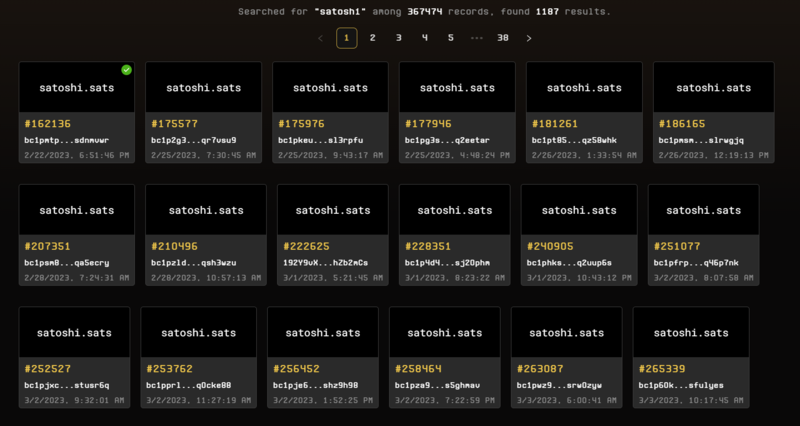Bitcoin Sats names are sequential inscriptions on satoshis that allow users to add any human-readable names and other data to their Bitcoin wallet address.
What is the Sats Name Standard (SNS)?
Sats Name Standard (SNS) allows you to add a name to your Bitcoin wallet. SNS integrates the records of readable names and the wallet to which it is linked to the Bitcoin blockchain and allows external services to use their technology in various ways, such as developing P2P payment systems that use human-readable names instead of traditional wallet addresses.
This naming feature in Bitcoin is comparable to naming services in Ethereum such as ENS (Ethereum Name Service) and Unstoppable Domains. Just like SNS, these services also allow you to add names to your wallet. However, it should be noted that SNS is still at the earliest stage and has not yet reached the level of implementation as the services mentioned above.
SNS names consist of a human-readable name or numbers with the suffix “.sats”. There are also a number of other naming projects that use the Ordinals protocol, which uses different extensions such as “.unisat” and “.xbt” to denote names added to a wallet using its facilities or protocols.

How Sats Names Work
In November 2021, the Bitcoin blockchain went through what has been termed its most significant advancement since the genesis block. The Taproot upgrade was intended to add a number of capabilities to the Bitcoin blockchain to better position it to keep pace with the growing applications of blockchain technology.
However, a loophole in Taproot allowed extra data to be added to virtual cryptographic tokens created on the Bitcoin network. This data ranges from simple sequences to multimedia objects such as pictures and videos. Satoshis with attached data can be spent like any other satoshi in the Bitcoin network, but the data they carry is recognized in the network and commands attached to them are also executed. Sequential NFTs and BRC tokens were created by adding multimedia and token contracts to satoshis, respectively.

In the above example, “P” indicates the sequential protocol of the naming service to be used, and “OP” indicates that the name to be registered is new. Using the “name” object, the registrant enters a desired name and uses the “rev” notation to assign that name to a wallet address. The “relay” notifies indexers that this SNS name points to another record, links them together, and gives a human-readable name to the corresponding post.
Once completed, the inscription is integrated into the network. However, there are a few points to note here. The selected names must be converted to lowercase letters during integration and there must be no spaces between the names. Any UTF-8 character is accepted and names can contain a mix of numbers and alphabets.
Only one name can be added to the order and SNS has a “first come” rule. The “first-first” rule means that the first registrant of any name is the rightful owner of the name. Therefore, a name can be registered as many times as possible, while the oldest record is the original name. The image below shows more than 1180 search results for the name “satoshi.sats”, but the oldest sequence number (#162136) is the actual owner of the name.

How to Check Availability of a Sats Name?
To prevent an already registered name from being saved, it is recommended to check if the name you want to register has already been taken. A good way to do this is to embed it in the Sats name API and search the web (https://api.sats.id/names/yourname.sats). To do this, replace your “name” in the URL with your preferred name and hit enter.
What Can Sats Names Be Used For?
Since its inception, SNS has found a number of various uses. It shows that it is likely to provide more benefits in the future. Sats availability status can be summarized as follows:
Human Readable Wallet Names
The primary purpose of the Sats name is to build a library of names on the Bitcoin blockchain and reflect the services that projects like ENS provide on the BTC network and even more. Currently, SNS names are not yet integrated into Bitcoin wallets as a substitute for alphanumeric Bitcoin wallet addresses, as is the case with Ethereum addresses.
However, native Ordinals wallets like UniSat have already developed this system on their platform. To send Bitcoin, BRC-20 tokens or sequential NFTs to a peer via the UniSat wallet, the name Sats attached to the recipient’s address can be used. This could be developed for normal Bitcoin wallet applications, depending on how successful ordinal numbers and Sats names will be in the future.
Human-readable names are important to Bitcoin adoption; after all, memorizing a long chain of numbers and letters as an address is nearly impossible. Addresses that can be memorized at a glance make payment easy and reduce the risk of sending money to the wrong recipient.
Sats names can be traded on NFT markets that support ordinal numbers. You can trade sats names on Magic Eden, Ordinals Wallet, and UniSat’s marketplace. You can list your Sats names and buy wallet names that interest you.
Data Storage
In addition to nominal values, extra data can be written to Satoshi using the sequence protocol. Using this feature, multimedia, data files and data strings can be added and stored on the Bitcoin network forever as part of the content of the Sats name. Considering that the blockchain itself is a good data storage option, keeping this data under a wallet address provides easy access. There have been some experimental inscription websites where everything on the site is hosted in Bitcoin and the “relay” command called Sats has been transferred to the inscription website.
Corporate Payment Structures
While Sats names are still maturing, a possible future use case for Sats names could enable institutions to accept Bitcoin payments made to the “.sats” suffix of their names.







